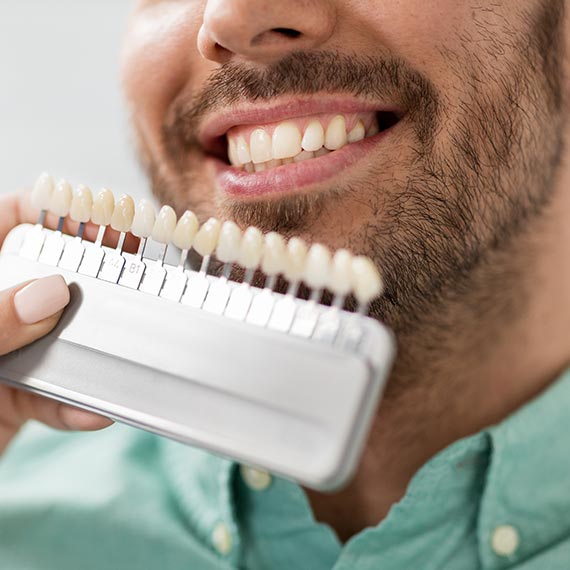Porcelain Veneers
Tooth Veneers are used to improve the colour, shape, and position of your teeth. They are thin strips of porcelain that are fixed to the front of your teeth to:
- Replace chipped and damaged teeth
- Replace worn teeth
- Improve the shape of your teeth
- Hide small gaps between your teeth
- Give you straighter teeth
- Give you whiter teeth
Book your dental veneer appointment with us at Victoria Road Dental Practice in Exmouth.
How are veneers fitted?
There are five steps in the process to fit veneers:
Step one: Consultation
Before you decide to have dental veneers fitted your dentist will explain the process to you and answer any questions you have.
They will then examine your teeth to make sure they are strong enough to have dental veneers fitted. This may include an x-ray so your dentist can see the underlying health of your teeth.
Step two: Impressions and models
The dentist will usually take an impression of your teeth so they can make a model of what your teeth will look like once the veneers are in place. However, if you are only having one or two veneers fitted this won’t be necessary.
Your dentist can make changes to the model until you’re happy with how your teeth will look.
Step three: Preparation
Your dentist will file the enamel on your teeth to make them slightly narrower so that your teeth won’t look bulky when the veneers are in place. This can be done with an anaesthetic but you may not need one.
Your dentist will then take another impression and send this to a specialist dental laboratory who will make your porcelain laminates.
If you’re having veneers to give you a whiter smile it’s a good idea to get the rest of your teeth whitened before you have your veneers fitted.
Step four: Dental veneer fitting
As soon as your veneers are back from the laboratory your dentist will contact you to make an appointment to have them fitted.
Before fixing the veneers in place the dentist will make sure they align with the rest of your teeth and don’t affect your bite. If they need to they can make slight alterations to make sure your veneers are a perfect fit.
Once you’re happy, the dentist will clean your teeth and apply an acid gel to create a strong surface for the veneers to stick to. They will then use dental cement to fix them in place on top of your natural teeth. Finally, they will use a curing light to harden the cement and make sure your veneers are firmly in place.
Step five: Recovery
Your gums may feel slightly tender after you’ve had veneers fitted. However, this should only last for a day or two.
Your dentist may also ask you back for a final check-up so they can polish your veneers and make sure you are happy with your new smile.
Book your veneer consultation online here or call us on 01395 272 018.




